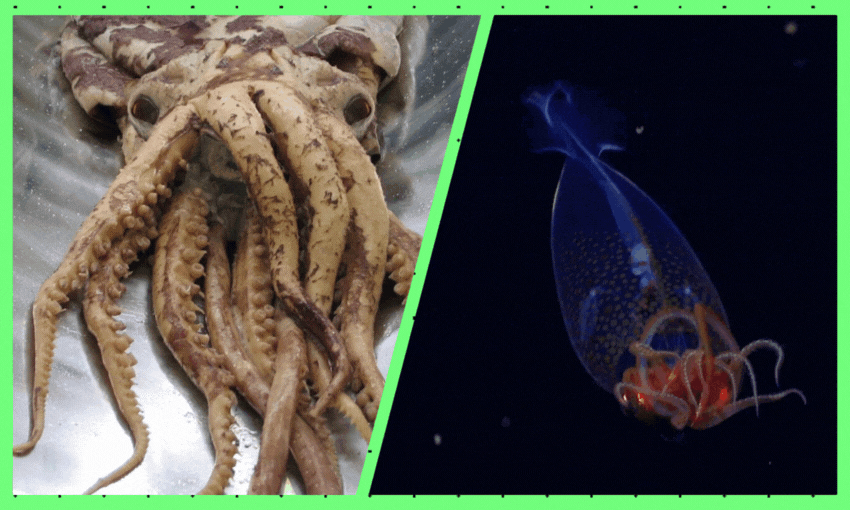We’ve known colossal squid exist for 100 years, yet this is the first time one has been seen alive in the deep. Best of all, it’s a beautiful baby.
Te Papa’s most popular exhibit is not known for her beauty. The colossal squid is laid out in a sealed bed of discolored liquid. She is limp, a little shrivelled and very, very dead. Her flesh is a washed out grey with peeling orange skin and stitched up damage. We are not seeing her in her best light (the darkness of the deep sea), but she is the only complete colossal squid on display in the world. It might cross the minds of the most sensitive visitors that perhaps it would be better for humans not to know what’s down there after all.
Since two arm crowns (the arms and tentacles found around a squid’s mouth) with a strange combination of suckers and hooks were found in a sperm whale stomach at the South Shetland Islands in 1925, we’ve known that colossal squids (not to be mistaken with giant squids) exist in the deep sea. Yet, for 100 years we’ve only seen them as remains in the stomachs of whales and seabirds, or on the surface, either dying or slipping back to the depths after following fish caught on long lines.
This all changed on March 9, and this morning, the embargo lifts on footage from the very first confirmed sighting of a colossal squid in its deep sea habitat. It’s a baby. The footage was captured by an Ocean Census expedition in the remote South Sandwich Islands in the South Atlantic Ocean.
“This animal is so beautiful – actually quite stunning,” says Dr Kat Bolstad, a world-renowned squid expert based at Auckland University of Technology who was called on to identify the baby squid. She thinks it looks like a “little glass sculpture”. Indeed colossal squid are one of about 60 species in the Cranchiidae family, commonly called glass squid. The baby squid, which is about 30cm long, is almost entirely transparent in the footage, but the colour cells (chromatophores) visible mean that it is iridescent, and it can “probably” switch to being opaque. This switch is thanks to the ability of the coloured chromatophores to expand and contract.
Bolstad is pleased that our first official glimpse of a colossal squid in the deep is of a baby. “It’s such a nice contrast to the monster hype or stuff of nightmares that gets thrown around for deep sea animals,” she says. “Our first look at a colossal squid shows us this life stage, rather than the large version, which, when we do see it, will inevitably have some of that hype.”
She seems to be suggesting that some people will inevitably cry that adult colossal squid do resemble monsters and the stuff of nightmares. Te Papa’s beloved exhibit comes to mind. Science is not sure yet what adult colossal squid look like when they’re alive and well in the deep sea, since we haven’t seen them. Bolstad says the specimen at Te Papa was likely not as transparent as the baby because the tissue of the mantle and fins gets “very thick” as they grow up. Colossal squid can probably reach lengths of 6–7m and can probably weigh more than 500kg. On the surface, adult colossal squid are opaque and a dark red or reddish purple colour, like the skin that’s coming off the one in Te Papa.
In an educational CGI video on Te Papa’s website, an adult colossal squid is pictured as a big red blob. Though they won’t look like little glass sculptures, Bolstad thinks that adults are likely to have more details than the blob. She expects that they will be able to control those colour cells to have some transparency and make different, changing patterns on their skin.
In any case, they will be a far cry from Te Papa’s prized corpse in that glass tank. “What we can see dead is a very poor approximation of the magnificence of these animals in life,” she says. Bolstad helped prepare that squid for exhibition back in 2008 and she says that “given the consistency of the muscle in that animal, she looks pretty good, all things considered”. She says when we look at the squid, we should consider what’s involved in getting a large gelatinous animal from the surface of the sea onto the deck of a ship, storing it, freezing it, thawing it, then putting it in a preservative. Flesh loses structural integrity throughout the whole process.
For Bolstad, glass squid, including colossal squid, are some of the most beautiful animals – when alive. Now that we have seen the little glass sculpture, we can try to erase previous monstrous images of them from our heads, and agree. The little baby is beautiful.
